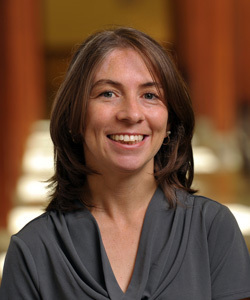

Karen Cowden Dahl
At the age of 15, Karen Cowden Dahl began to seriously consider what she wanted to do with her life. Her decision would be an easy one. You might say, her career choice was a product of her environment, similar to the disease she researches and fights at the Mike and Josie Harper Cancer Research Institute on the University of Notre Dame campus.
“My mother was a nurse, my father was a pharmacist,” she reflected recently. “So I had the medical background. For a year or so I thought about becoming a medical doctor. But then I decided I wanted to find out what causes diseases because before you cure you have to know what the cause is.”
That career path has wound its way from west Texas through Pennsylvania and New Mexico to South Bend. Prof. Cowden Dahl, adjunct assistant professor of chemistry and biochemistry at Notre Dame and assistant professor of biochemistry and molecular biology for the Indiana University School of Medicine, is one of many leading the fight against ovarian cancer.
Known as the silent killer of women, ovarian cancer is still so undetectable that when it eventually is diagnosed, it is usually in the latter stages when a full cure is virtually impossible. The American Cancer Society estimates that in 2015 there will be more than 21,000 new cases of ovarian cancer detected and more than 14,000 deaths from the disease.
It’s a battle you prepare to fight for the long haul, and Cowden Dahl, who recently received a new grant from the Department of Defense Ovarian Cancer Research Program for a project entitled “ARID3B Induces CD133-Mediated Homing to the Ovarian Cancer Metastatic Niche,” is as determined to find the cancer’s secrets as the disease is determined to keep them secret.
How cruel is ovarian cancer? Women should be aware if anyone on either side of their family has a history of the disease. Additionally it is always important to listen to what your body is trying to tell you. Sadly, some warning signs such as bloating, irritable bowl syndrome, increased abdominal size, abdominal pain, pelvic pain, changes in eating habits, stress and depression are often ignored. By the time a woman finally does decide to see her doctor, the disease may have progressed from its early stages and spread to nearby tissues and organs.
“Ovarian cancer used to be called the silent killer because it didn’t have a lot of symptoms,” Cowden Dahl said. “There is a local doctor, Dr. Michael W. Method, who uses the phrase ‘It whispers, so listen.’ There are actually symptoms, even in the early stages, but they are so vague that you’d never think it was cancer. Things you would not attribute to the ovaries. It’s usually only when the symptoms become extreme that a woman will come in and get checked.”
If symptoms persist for two or more weeks, a doctor might prescribe blood screens and an ultrasound, and if a tumor is found, the treatment is usually surgery to remove the tumor and follow-up chemotherapy and radiation.
The problem is ovarian cancer is a determined killer, too. The follow-up treatment sometimes doesn’t kill off all the bad cancer stem cells, which go off and attach themselves elsewhere and there’s a re-occurrence of the disease. That’s the mystery Cowden Dahl is trying to unlock with her Department of Defense grant.
“We’re studying a protein called CD133 and it’s a marker on these cancer stem cells,” Cowden Dahl said. “We think the cancer stem cells are more resistant to chemotherapy than the typical cells. We also believe the cancer stem cells play a role in the spreading of the disease. It’s the spreading of the disease that kills most patients.
“The vast majority of women have metastatic disease which means it has spread. We need to figure out what is going on and how can we treat those women. My hypothesis is that this protein (CD133) on the stem cell is helping the disease spread. I want to determine whether this protein helps the disease spread. If it does, then it would be really great to design therapies that recognize CD133, which should limit spread of the disease and resistance to treatment. That would be targeted therapy. If we could target only the cells that have this protein, then we can save more lives.”
And in doing so, honor those lives who couldn’t be saved. It’s why Cowden Dahl got involved in the fight to eradicate cancers of all kinds.
“My mother died 30 years ago from a brain tumor,” she said. “Both of my grandmothers died of cancer. I had a grandfather who died of cancer. I watched them all suffer. That’s why I wanted to study the disease. I had a personal interest in wanting to find out more about cancer, trying to reduce the suffering and working toward a cure. I am not naïve enough to believe I am going to find the potion that is going to cure everything. But as a scientist, what we do is create new knowledge. We’re unlocking the puzzle pieces that are going to allow us to make those advancements. So every little step is important.”
And every little step gets Karen Cowden Dahl and her Harper Cancer Research Institute colleagues closer to their final destination – a world free of the disease.
Originally published by Jenna Bilinski at harpercancer.nd.edu on February 16, 2015.